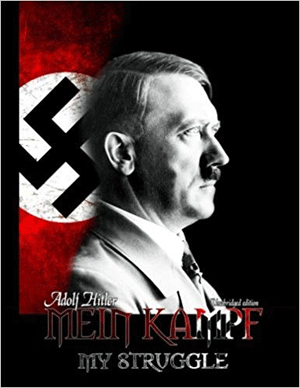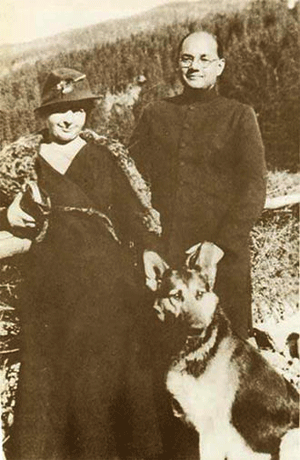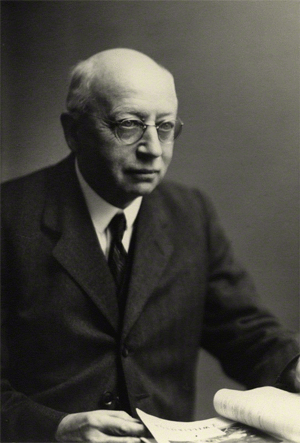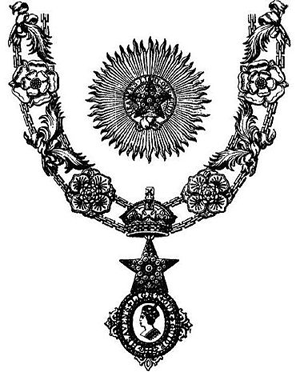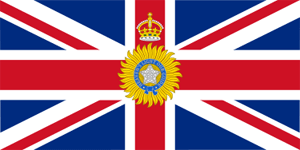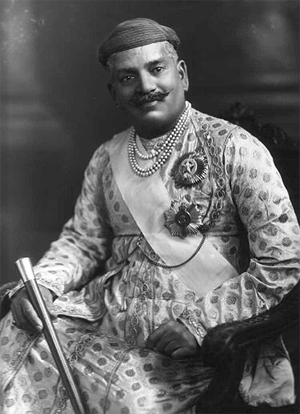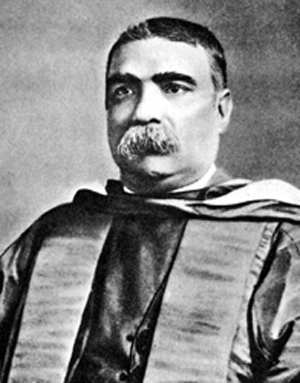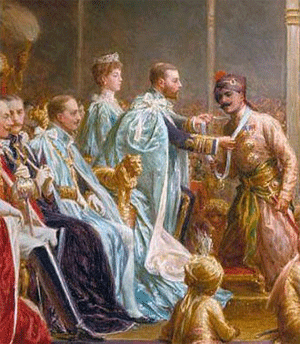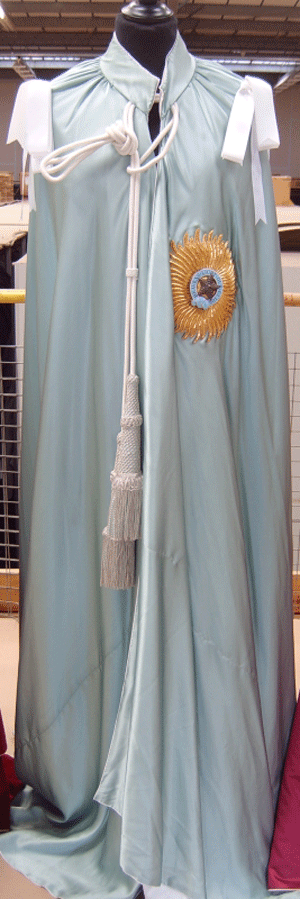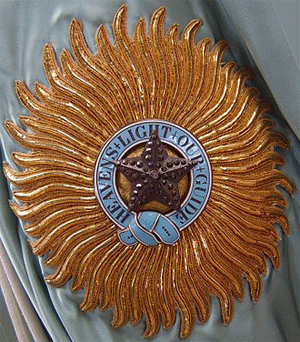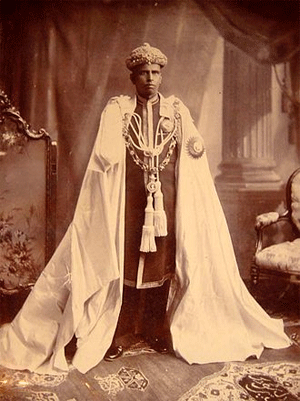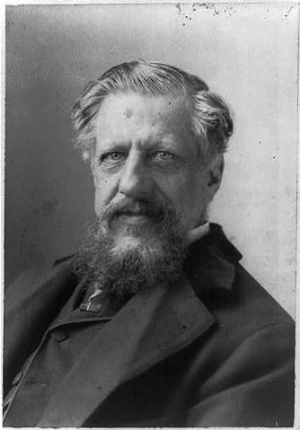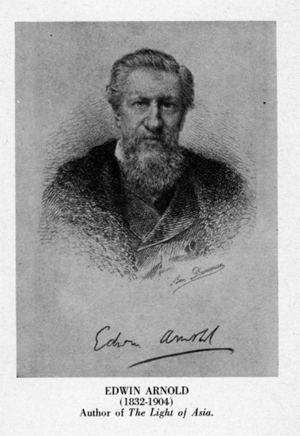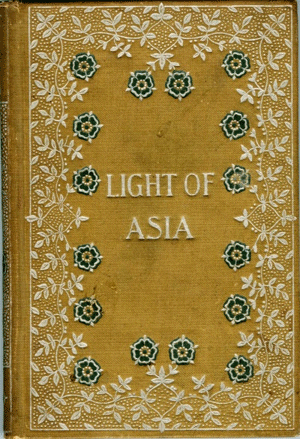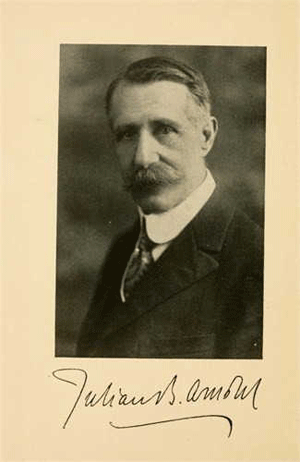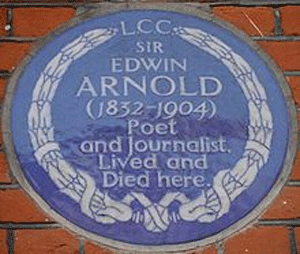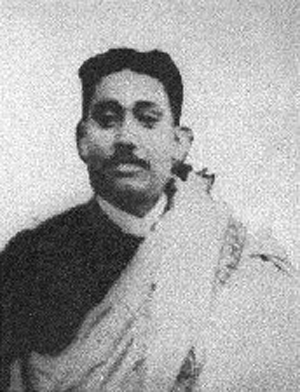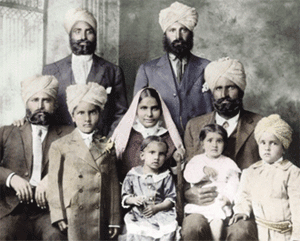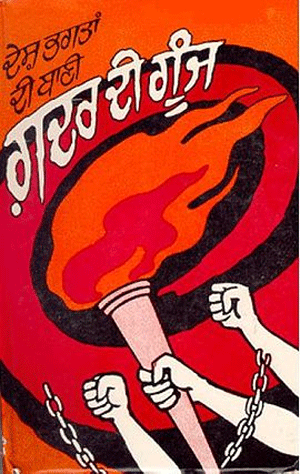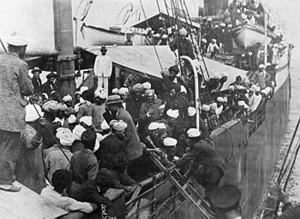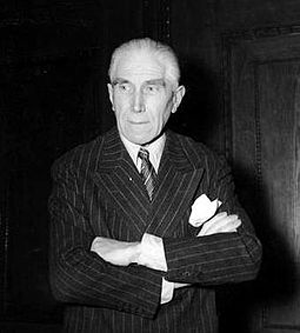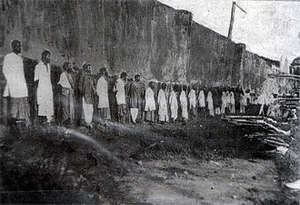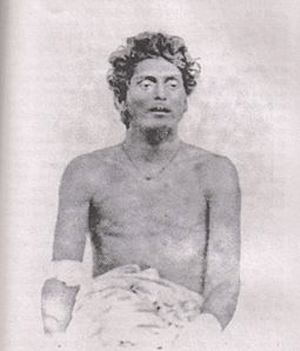Subhas Chandra Bose
by Wikipedia
Accessed: 3/25/19
NOTICE: THIS WORK MAY BE PROTECTED BY COPYRIGHT
YOU ARE REQUIRED TO READ THE COPYRIGHT NOTICE AT THIS LINK BEFORE YOU READ THE FOLLOWING WORK, THAT IS AVAILABLE SOLELY FOR PRIVATE STUDY, SCHOLARSHIP OR RESEARCH PURSUANT TO 17 U.S.C. SECTION 107 AND 108. IN THE EVENT THAT THE LIBRARY DETERMINES THAT UNLAWFUL COPYING OF THIS WORK HAS OCCURRED, THE LIBRARY HAS THE RIGHT TO BLOCK THE I.P. ADDRESS AT WHICH THE UNLAWFUL COPYING APPEARED TO HAVE OCCURRED. THANK YOU FOR RESPECTING THE RIGHTS OF COPYRIGHT OWNERS.
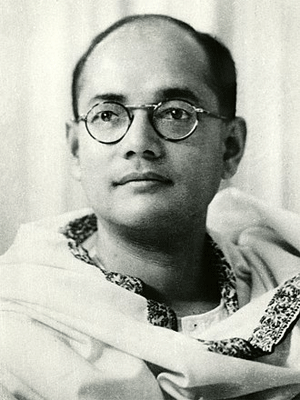
Subhas Chandra Bose
Head of State and Government (Prime Minister) of the Provisional Government of Free India (Undivided India) (Ārzī Hukūmat-e-Āzād Hind)
In office: 21 October 1943 – 18 August 1945
Preceded by: Office created
Succeeded by: Office abolished
President of the Indian National Congress
In office: 1938–1939
Preceded by: Jawaharlal Nehru
Succeeded by: Rajendra Prasad
Personal details
Born: Subhas Chandra Bose, 23 January 1897, Cuttack, British India
Died: 18 August 1945 (aged 48), Taihoku, Japanese Taiwan (present-day Taipei)
Political party: Indian National Congress; Forward Bloc (1939–1940)
Spouse(s): Emilie Schenkl
Children: Anita Bose Pfaff
Mother: Prabhavati Dutt
Father: Janakinath Bose
Education: Ravenshaw Collegiate; Scottish Church College
Alma mater: University of Calcutta; Fitzwilliam College
Known for: Indian nationalism
Subhas Chandra Bose (23 January 1897 – 18 August 1945)[1][a] was an Indian nationalist whose defiant patriotism made him a hero in India,[2][ b][3][c][4][d] but whose attempt during World War II to rid India of British rule with the help of Nazi Germany and Imperial Japan left a troubled legacy.[5][e][6][f][2][g] The honorific Netaji (Hindustani: "Respected Leader"), first applied in early 1942 to Bose in Germany by the Indian soldiers of the Indische Legion and by the German and Indian officials in the Special Bureau for India in Berlin, was later used throughout India.[7][h]
Bose had been a leader of the younger, radical, wing of the Indian National Congress in the late 1920s and 1930s, rising to become Congress President in 1938 and 1939.[8][ i] However, he was ousted from Congress leadership positions in 1939 following differences with Mahatma Gandhi and the Congress high command.[9] He was subsequently placed under house arrest by the British before escaping from India in 1940.[10]
Bose arrived in Germany in April 1941, where the leadership offered unexpected, if sometimes ambivalent, sympathy for the cause of India's independence, contrasting starkly with its attitudes towards other colonised peoples and ethnic communities.[11][12]
Freda married BPL on June 12, 1933, at the Oxford Registrar’s Office. She was twenty-two and he was twenty-six….
Their creative, radical Oxford days were over. Both Freda and BPL received their degrees and a whole new life beckoned. It was not what Freda had imagined. She had successfully lined up a job as a cub reporter on the Derby Telegraph, her first stepping stone to Fleet Street (as she had intended). Instead she went to Germany with her new husband, who had won a Humboldt scholarship at the Friedrich Wilhelm University in Berlin, to research a PHD in Political Science.
“Bedi was concerned about the rise of Hitler, but he thought that as long as he didn’t get a chance to rant in Parliament, it would be all right. He was going to keep a very keen eye on the situation,” she said. She was not to see her homeland again for fourteen years….
By the time Freda reached Berlin, she was pregnant, and delighted with the prospect of motherhood. BPL somewhat protectively decided that she should not work, but instead live quietly in the charming little cottage they had found on the bank of Lake Wannsee. “It was really a lovely place, with a beautiful garden, and we had some very happy months there preparing for the child,” she said. She busied herself with making baby clothes, but could not resist going to Berlin University to study Hindi with a Punjabi professor – a necessary preparation, she thought, for a life on the subcontinent, and to counteract the full-on domesticity she found herself in….
BPL refrained from any political activity in Germany, although he was keeping up-to-date with the Free India movement in India. A frequent visitor to their lakeside cottage was Subhas Chandra Bose, who went on to become one of the most prominent and controversial leaders of the independence movement. Bose was educated at Cambridge and also had a European wife – Emilie Schenkl, an Austrian. He made it a point to visit sympathetic Indian students living in Europe, and the couple had much in common with Freda and BPL Bedi.
“We came to know Bose intimately, and a deep friendship grew,” said BPL. Bose was a hard-core communist, a great admirer of the Soviet Union, who maintained that only an authoritarian state, not democracy, would be able to reshape India. (Later he was forced to resign as present of the Indian National Congress because his platform of violent resistance clashed with Gandhi’s peaceful pathway.)
In Germany, however, Bose, won the young BPL over completely. “Freda and I were both fired up with the patriotic zeal of liberating the motherland from British imperialism,” BPL said. “While we were in Berlin, an eminent journalist asked me what was my agenda for India. ‘Live dangerously,’ I replied. ‘Live dangerously for every form of exploitation of man by man. Live dangerously for every form of injustice. Live dangerously for any violation of human dignity.’”
On May 13, 1934, Freda gave birth to a son after just a four-hour labor….They named him Ranga after the Indian statesman who had defeated the political opposition to their marriage, ten months previously….
BPL had not joined any political club at Berlin University, nor was he taking part in any political activities, but he sensed that tension was mountain. He was friendly with many of the Indian students living in the International Houses, which were being increasingly dominated by Nazi representatives.
In August 1934, Hitler was made fuhrer. The morning the news broke, BPL put down his paper and announced, “Tomorrow we get on the train and go to Geneva. It’s not safe here anymore.”
“He knew that Hitler could swoop down on the Indian students, which was precisely what happened,” said Freda. The life of drama and danger that she pledged to share with Bedi had begun. “You can imagine the state I was in, having to pack up everything in one day, and with BPL having to get the visas for Switzerland. But the next morning we were on the train!” she said
After their hasty exit, they spent a few pleasant weeks staying in accommodations that had been arranged by their old Oxford professor, Alfred Zimmern [Professor Sir Alfred Eckhard Zimmern, whose name is associated with the founding of the League of Nations], who ran a school there. In October 1934, they finally made the decision to go to India and make it their permanent home. They sailed on the SS Conte Verde from northern Italy to Bombay, a journey of three weeks.
-- The Revolutionary Life of Freda Bedi, by Vicki Mackenzie
In November 1941, with German funds, a Free India Centre was set up in Berlin, and soon a Free India Radio, on which Bose broadcast nightly. A 3,000-strong Free India Legion, comprising Indians captured by Erwin Rommel's Afrika Korps, was also formed to aid in a possible future German land invasion of India.[13] By spring 1942, in light of Japanese victories in southeast Asia and changing German priorities, a German invasion of India became untenable, and Bose became keen to move to southeast Asia.[14] Adolf Hitler, during his only meeting with Bose in late May 1942, suggested the same, and offered to arrange for a submarine.[15] During this time Bose also became a father; his wife, [16] or companion,[17][j] Emilie Schenkl, whom he had met in 1934, gave birth to a baby girl in November 1942.[16][11] Identifying strongly with the Axis powers, and no longer apologetically, Bose boarded a German submarine in February 1943.[18][19] In Madagascar, he was transferred to a Japanese submarine from which he disembarked in Japanese-held Sumatra in May 1943.[18]
With Japanese support, Bose revamped the Indian National Army (INA), then composed of Indian soldiers of the British Indian army who had been captured in the Battle of Singapore.[20] To these, after Bose's arrival, were added enlisting Indian civilians in Malaya and Singapore. The Japanese had come to support a number of puppet and provisional governments in the captured regions, such as those in Burma, the Philippines and Manchukuo. Before long the Provisional Government of Free India, presided by Bose, was formed in the Japanese-occupied Andaman and Nicobar Islands.[20][21][k] Bose had great drive and charisma—creating popular Indian slogans, such as "Jai Hind,"—and the INA under Bose was a model of diversity by region, ethnicity, religion, and even gender. However, Bose was regarded by the Japanese as being militarily unskilled,[22][l] and his military effort was short-lived. In late 1944 and early 1945 the British Indian Army first halted and then devastatingly reversed the Japanese attack on India. Almost half the Japanese forces and fully half the participating INA contingent were killed.[23][m] The INA was driven down the Malay Peninsula, and surrendered with the recapture of Singapore. Bose had earlier chosen not to surrender with his forces or with the Japanese, but rather to escape to Manchuria with a view to seeking a future in the Soviet Union which he believed to be turning anti-British. He died from third degree burns received when his plane crashed in Taiwan.[24][n] Some Indians, however, did not believe that the crash had occurred,[4][o] with many among them, especially in Bengal, believing that Bose would return to gain India's independence.[25][p][26][q][27][r]
The Indian National Congress, the main instrument of Indian nationalism, praised Bose's patriotism but distanced itself from his tactics and ideology,[28][s] especially his collaboration with fascism.[29] The British Raj, though never seriously threatened by the INA,[30][t][31][u] charged 300 INA officers with treason in the INA trials, but eventually backtracked in the face both of popular sentiment and of its own end.[32][v][29][2]
Biography
1897–1921: Early life
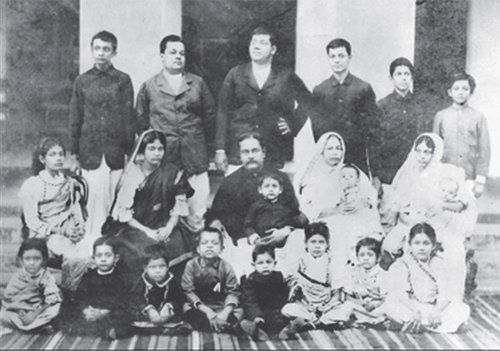
Subhas Bose, standing, extreme right, with his family of 14 siblings in Cuttack, ca. 1905.
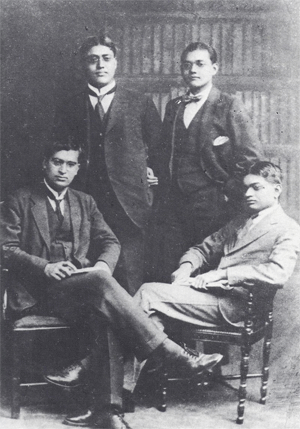
Subhas Bose (standing, right) with friends in England, 1920
Subhas Chandra Bose was born on 23 January 1897 (at 12.10 pm) in Cuttack, Orissa Division, Bengal Province, to Prabhavati Dutt Bose and Janakinath Bose, an advocate belonging to a Kayastha[33][w] family.[34] He was the ninth in a family of 14 children. His family was well to do.[33]
He was admitted to the Protestant European School (presently Stewart High School) in Cuttack, like his brothers and sisters, in January 1902. He continued his studies at this school which was run by the Baptist Mission up to 1909 and then shifted to the Ravenshaw Collegiate School. Here, he was ridiculed by his fellow students because he knew very little Bengali. The day Subhas was admitted to this school, Beni Madhab Das, the headmaster, understood how brilliant and scintillating his genius was. After securing the second position in the matriculation examination in 1913, he got admitted to the Presidency College where he studied briefly.[35] He was influenced by the teachings of Swami Vivekananda and Ramakrishna after reading their works at the age of 16. He felt that his religion was more important than his studies.[33]
In those days, the British in Calcutta often made offensive remarks to the Indians in public places and insulted them openly. This behavior of the British as well as the outbreak of World War I began to influence his thinking.[33]
His nationalistic temperament came to light when he was expelled for assaulting Professor Oaten(who had manhandled some Indian students[33]) for the latter's anti-India comments. He was expelled although he appealed that he only witnessed the assault and did not actually participate in it.[33] He later joined the Scottish Church College at the University of Calcutta and passed his B.A. in 1918 in philosophy.[36] Bose left India in 1919 for England with a promise to his father that he would appear in the Indian Civil Services (ICS) examination. He went to study in Fitzwilliam College, Cambridge and matriculated on 19 November 1919. He came fourth in the ICS examination and was selected, but he did not want to work under an alien government which would mean serving the British. As he stood on the verge of taking the plunge by resigning from the Indian Civil Service in 1921, he wrote to his elder brother Sarat Chandra Bose: "Only on the soil of sacrifice and suffering can we raise our national edifice."[37]
He resigned from his civil service job on 23 April 1921 and returned to India.[38]
1921–1932: Indian National Congress

Bose at the inauguration of the India Society in Prague in 1926.
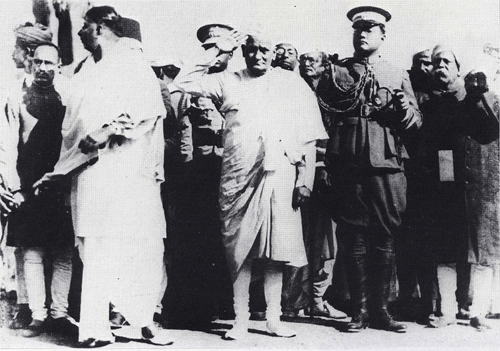
Subhas Bose, General Officer Commanding, Congress Volunteer Corps (in military uniform) with Congress president, Motilal Nehru, taking the salute. Annual meeting, Indian National Congress, December 29, 1928.
He started the newspaper Swaraj and took charge of publicity for the Bengal Provincial Congress Committee.[39] His mentor was Chittaranjan Das who was a spokesman for aggressive nationalism in Bengal. In the year 1923, Bose was elected the President of All India Youth Congress and also the Secretary of Bengal State Congress. He was also the editor of the newspaper "Forward", founded by Chittaranjan Das.[40] Bose worked as the CEO of the Calcutta Municipal Corporation for Das when the latter was elected mayor of Calcutta in 1924.[41] In a roundup of nationalists in 1925, Bose was arrested and sent to prison in Mandalay, where he contracted tuberculosis.[42]
In 1927, after being released from prison, Bose became general secretary of the Congress party and worked with Jawaharlal Nehru for independence. In late December 1928, Bose organised the Annual Meeting of the Indian National Congress in Calcutta.[43] His most memorable role was as General Officer Commanding (GOC) Congress Volunteer Corps.[43] Author Nirad Chaudhuri wrote about the meeting:
Bose organized a volunteer corps in uniform, its officers were even provided with steel-cut epaulettes ... his uniform was made by a firm of British tailors in Calcutta, Harman's. A telegram addressed to him as GOC was delivered to the British General in Fort William and was the subject of a good deal of malicious gossip in the (British Indian) press. Mahatma Gandhi is a sincere pacifist vowed to non-violence, did not like the strutting, clicking of boots, and saluting, and he afterward described the Calcutta session of the Congress as a Bertram Mills circus, which caused a great deal of indignation among the Bengalis.[43]
A little later, Bose was again arrested and jailed for civil disobedience; this time he emerged to become Mayor of Calcutta in 1930.[42]
1933–1937: Illness, Austria, Emilie Schenkl
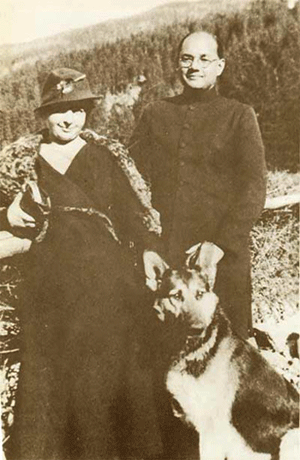
Bose with Emilie Schenkl, in Bad Gastein, Austria, 1936.
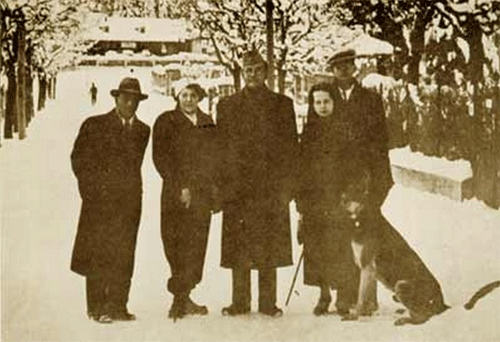
Bose, INC president-elect, center, in Bad Gastein, Austria, December 1937, with (left to right) A. C. N. Nambiar (Bose's second-in-command, Berlin, 1941–1945), Heidi Fulop-Miller, Schenkl, and Amiya Bose.
During the mid-1930s Bose travelled in Europe, visiting Indian students and European politicians, including Benito Mussolini. He observed party organisation and saw communism and fascism in action. In this period, he also researched and wrote the first part of his book The Indian Struggle, which covered the country's independence movement in the years 1920–1934. Although it was published in London in 1935, the British government banned the book in the colony out of fears that it would encourage unrest.[44]
-- Mein Kampf: My Struggle, by Adolf Hitler
1937–1940: Indian National Congress
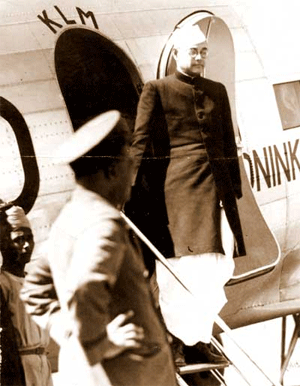
Bose, president-elect, INC, arrives in Calcutta, 24 January 1938, after two-month vacation in Austria.[x][y]
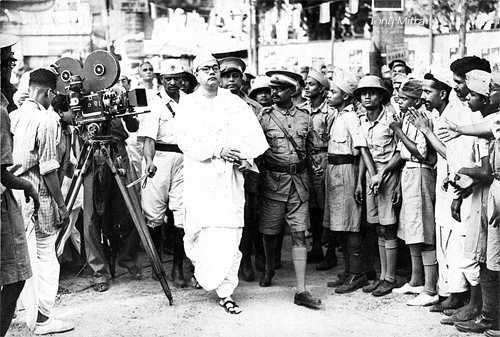
Bose arriving at the 1939 annual session of the Congress, where he was re-elected, but later had to resign after disagreements with Gandhi and the Congress High Command.
By 1938 Bose had become a leader of national stature and agreed to accept nomination as Congress President.He stood for unqualified Swaraj (self-governance), including the use of force against the British. This meant a confrontation with Mohandas Gandhi, who in fact opposed Bose's presidency,[47] splitting the Indian National Congress party. Bose attempted to maintain unity, but Gandhi advised Bose to form his own cabinet. The rift also divided Bose and Nehru. Bose appeared at the 1939 Congress meeting on a stretcher. He was elected president again over Gandhi's preferred candidate Pattabhi Sitaramayya.[48] U. Muthuramalingam Thevar strongly supported Bose in the intra-Congress dispute. Thevar mobilised all south India votes for Bose.[49] However, due to the manoeuvrings of the Gandhi-led clique in the Congress Working Committee, Bose found himself forced to resign from the Congress presidency.
On 22 June 1939 Bose organised the All India Forward Bloc a faction within the Indian National Congress,[50] aimed at consolidating the political left, but its main strength was in his home state, Bengal. U Muthuramalingam Thevar, who was a staunch supporter of Bose from the beginning, joined the Forward Bloc. When Bose visited Madurai on 6 September, Thevar organised a massive rally as his reception.
When Subash Chandra Bose was heading to Madurai, on an invitation of Muthuramalinga Thevar to amass support for the Forward Bloc, he passed through Madras and spent three days at Gandhi Peak. His correspondence reveals that despite his clear dislike for British subjugation, he was deeply impressed by their methodical and systematic approach and their steadfastly disciplinarian outlook towards life. In England, he exchanged ideas on the future of India with British Labour [Labor] Party leaders and political thinkers like Lord Halifax, George Lansbury, Clement Attlee, Arthur Greenwood, Harold Laski, J.B.S. Haldane, Ivor Jennings, G.D.H. Cole, Gilbert Murray and Sir Stafford Cripps.
He came to believe that an independent India needed socialist authoritarianism, on the lines of Turkey's Kemal Atatürk, for at least two decades. For political reasons Bose was refused permission by the British authorities to meet Atatürk at Ankara. During his sojourn in England Bose tried to schedule appointments with several politicians, but only the Labour [Labor] Party and Liberal politicians agreed to meet with him. Conservative Party officials refused to meet him or show him courtesy because he was a politician coming from a colony. In the 1930s leading figures in the Conservative Party had opposed even Dominion status for India. It was during the Labour [Labor] Party government of 1945–1951, with Attlee as the Prime Minister, that India gained independence.
On the outbreak of war, Bose advocated a campaign of mass civil disobedience to protest against Viceroy Lord Linlithgow's decision to declare war on India's behalf without consulting the Congress leadership. Having failed to persuade Gandhi of the necessity of this, Bose organised mass protests in Calcutta calling for the 'Holwell Monument' commemorating the Black Hole of Calcutta, which then stood at the corner of Dalhousie Square, to be removed.[51] He was thrown in jail by the British, but was released following a seven-day hunger strike. Bose's house in Calcutta was kept under surveillance by the CID.[52]
1941–1943: Nazi Germany
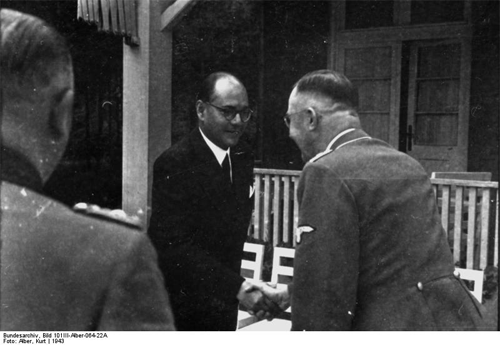
Bose greeting Heinrich Himmler (right), the Nazi Minister of Interior, head of the SS, and the Gestapo, 1942.
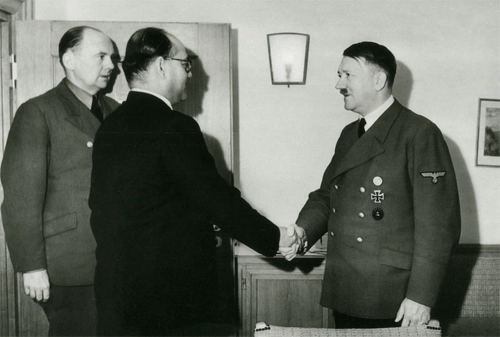
Subhas Bose meeting Adolf Hitler
Bose's arrest and subsequent release set the scene for his escape to Germany, via Afghanistan and the Soviet Union. A few days before his escape, he sought solitude and, on this pretext, avoided meeting British guards and grew a beard. Late night 16 January 1941, the night of his escape, he dressed as a Pathan (brown long coat, a black fez-type coat and broad pyjamas) to avoid being identified. Bose escaped from under British surveillance from his Elgin Road house in Calcutta about 01:25AM on 17 January 1941, accompanied by his nephew Sisir Kumar Bose in a German-made Wanderer W24 Sedan car, which would take him to Gomoh Railway Station in then state of Bihar, India. The car (Registration No. BLA 7169) was bought by Subhash Chandra Bose's elder brother Sarat Chandra Bose in 1937. The car is now on display at his Elgin Road home in Calcutta, India.[53][54][55][56]
He journeyed to Peshawar with the help of the Abwehr, where he was met by Akbar Shah, Mohammed Shah and Bhagat Ram Talwar. Bose was taken to the home of Abad Khan, a trusted friend of Akbar Shah's. On 26 January 1941, Bose began his journey to reach Russia through British India's North West frontier with Afghanistan. For this reason, he enlisted the help of Mian Akbar Shah, then a Forward Bloc leader in the North-West Frontier Province. Shah had been out of India en route to the Soviet Union, and suggested a novel disguise for Bose to assume. Since Bose could not speak one word of Pashto, it would make him an easy target of Pashto speakers working for the British. For this reason, Shah suggested that Bose act deaf and dumb, and let his beard grow to mimic those of the tribesmen. Bose's guide Bhagat Ram Talwar, unknown to him, was a Soviet agent.[55][56][57]
Supporters of the Aga Khan III helped him across the border into Afghanistan where he was met by an Abwehr unit posing as a party of road construction engineers from the Organization Todt who then aided his passage across Afghanistan via Kabul to the border with Soviet Russia. After assuming the guise of a Pashtun insurance agent ("Ziaudddin") to reach Afghanistan, Bose changed his guise and travelled to Moscow on the Italian passport of an Italian nobleman "Count Orlando Mazzotta". From Moscow, he reached Rome, and from there he travelled to Germany.[55][56][58] Once in Russia the NKVD transported Bose to Moscow where he hoped that Russia's traditional enmity to British rule in India would result in support for his plans for a popular rising in India. However, Bose found the Soviets' response disappointing and was rapidly passed over to the German Ambassador in Moscow, Count von der Schulenburg. He had Bose flown on to Berlin in a special courier aircraft at the beginning of April where he was to receive a more favourable hearing from Joachim von Ribbentrop and the Foreign Ministry officials at the Wilhelmstrasse.[55][56][59]
In Germany, he was attached to the Special Bureau for India under Adam von Trott zu Solz which was responsible for broadcasting on the German-sponsored Azad Hind Radio.[60] He founded the Free India Center in Berlin, and created the Indian Legion (consisting of some 4500 soldiers) out of Indian prisoners of war who had previously fought for the British in North Africa prior to their capture by Axis forces. The Indian Legion was attached to the Wehrmacht, and later transferred to the Waffen SS. Its members swore the following allegiance to Hitler and Bose: "I swear by God this holy oath that I will obey the leader of the German race and state, Adolf Hitler, as the commander of the German armed forces in the fight for India, whose leader is Subhas Chandra Bose". This oath clearly abrogates control of the Indian legion to the German armed forces whilst stating Bose's overall leadership of India. He was also, however, prepared to envisage an invasion of India via the USSR by Nazi troops, spearheaded by the Azad Hind Legion; many have questioned his judgment here, as it seems unlikely that the Germans could have been easily persuaded to leave after such an invasion, which might also have resulted in an Axis victory in the War.[58]
In all, 3,000 Indian prisoners of war signed up for the Free India Legion. But instead of being delighted, Bose was worried. A left-wing admirer of Russia, he was devastated when Hitler's tanks rolled across the Soviet border. Matters were worsened by the fact that the now-retreating German army would be in no position to offer him help in driving the British from India. When he met Hitler in May 1942, his suspicions were confirmed, and he came to believe that the Nazi leader was more interested in using his men to win propaganda victories than military ones. So, in February 1943, Bose turned his back on his legionnaires and slipped secretly away aboard a submarine bound for Japan. This left the men he had recruited leaderless and demoralised in Germany.[58][61]
Bose lived in Berlin from 1941 until 1943. During his earlier visit to Germany in 1934, he had met Emilie Schenkl, the daughter of an Austrian veterinarian whom he married in 1937. Their daughter is Anita Bose Pfaff.[62] Bose's party, the Forward Bloc, has contested this fact.[63]
1943–1945: Japanese-occupied Asia
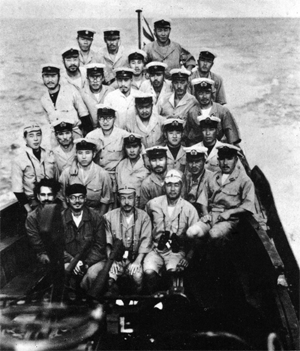
The crew of Japanese submarine I-29 after the rendezvous with German submarine U-180 300 sm southeast of Madagascar; Bose is sitting in the front row (28 April 1943).
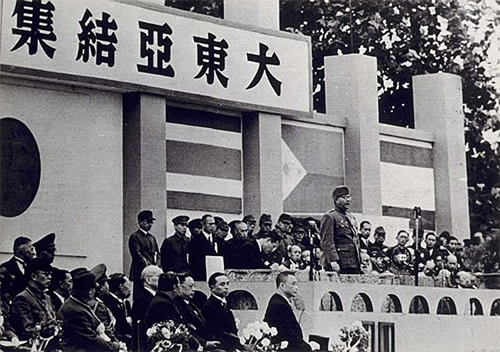
Bose speaking in Tokyo in 1943.
In 1943, after being disillusioned that Germany could be of any help in gaining India's independence, he left for Japan. He travelled with the German submarine U-180 around the Cape of Good Hope to the southeast of Madagascar, where he was transferred to the I-29 for the rest of the journey to Imperial Japan. This was the only civilian transfer between two submarines of two different navies in World War II.[55][56]
The Indian National Army (INA) was the brainchild of Japanese Major (and post-war Lieutenant-General) Iwaichi Fujiwara, head the Japanese intelligence unit Fujiwara Kikan and had its origins, first in the meetings between Fujiwara and the president of the Bangkok chapter of the Indian Independence League, Pritam Singh Dhillon, and then, through Pritam Singh's network, in the recruitment by Fujiwara of a captured British Indian army captain, Mohan Singh on the western Malayan peninsula in December 1941; Fujiwara's mission was "to raise an army which would fight alongside the Japanese army."[64][65] After the initial proposal by Fujiwara the Indian National Army was formed as a result of discussion between Fujiwara and Mohan Singh in the second half of December 1941, and the name chosen jointly by them in the first week of January 1942.[66]
This was along the concept of—and with support of—what was then known as the Indian Independence League, headed by expatriate nationalist leader Rash Behari Bose. The first INA was however disbanded in December 1942 after disagreements between the Hikari Kikan and Mohan Singh, who came to believe that the Japanese High Command was using the INA as a mere pawn and propaganda tool. Mohan Singh was taken into custody and the troops returned to the prisoner-of-war camp. However, the idea of an independence army was revived with the arrival of Subhas Chandra Bose in the Far East in 1943. In July, at a meeting in Singapore, Rash Behari Bose handed over control of the organisation to Subhas Chandra Bose. Bose was able to reorganise the fledgling army and organise massive support among the expatriate Indian population in south-east Asia, who lent their support by both enlisting in the Indian National Army, as well as financially in response to Bose's calls for sacrifice for the independence cause. INA had a separate women's unit, the Rani of Jhansi Regiment (named after Rani Lakshmi Bai) headed by Capt. Lakshmi Swaminathan, which is seen as a first of its kind in Asia.[67][68]
Even when faced with military reverses, Bose was able to maintain support for the Azad Hind movement. Spoken as a part of a motivational speech for the Indian National Army at a rally of Indians in Burma on 4 July 1944, Bose's most famous quote was "Give me blood, and I shall give you freedom!" In this, he urged the people of India to join him in his fight against the British Raj.[citation needed] Spoken in Hindi, Bose's words are highly evocative. The troops of the INA were under the aegis of a provisional government, the Azad Hind Government, which came to produce its own currency, postage stamps, court and civil code, and was recognised by nine Axis states — Germany, Japan, Italian Social Republic, the Independent State of Croatia, Wang Jingwei regime in Nanjing, China, a provisional government of Burma, Manchukuo and Japanese-controlled Philippines. Recent researches[which?] have shown that the USSR too had diplomatic contact with the "Provisional Government of Free India".[citation needed] Of those countries, five were authorities established under Axis occupation. This government participated in the so-called Greater East Asia Conference as an observer in November 1943.[citation needed]
The INA's first commitment was in the Japanese thrust towards Eastern Indian frontiers of Manipur. INA's special forces, the Bahadur Group, were extensively involved in operations behind enemy lines both during the diversionary attacks in Arakan, as well as the Japanese thrust towards Imphal and Kohima, along with the Burmese National Army led by Ba Maw and Aung San.[citation needed]
The Japanese also took possession of Andaman and Nicobar Islands in 1942 and a year later, the Provisional Government and the INA were established in the Andaman and Nicobar Islands with Lt Col. A.D. Loganathan appointed its Governor General. The islands were renamed Shaheed (Martyr) and Swaraj (Independence). However, the Japanese Navy remained in essential control of the island's administration. During Bose's only visit to the islands in early 1944, apparently in the interest of shielding Bose from attaining a full knowledge of ultimate Japanese intentions, Bose's Japanese hosts carefully isolated him from the local population. At that time the island's Japanese administration had been torturing the leader of the island's Indian Independence League, Dr. Diwan Singh, who later died of his injuries in the Cellular Jail. During Bose's visit to the islands several locals attempted to alert Bose to Dr. Singh's plight, but apparently without success. During this time Lt. Col Loganathan became aware of his lack of any genuine administrative control and resigned in protest as Governor General, later returning to the Government's headquarters in Rangoon.[69][70]
On the Indian mainland, an Indian Tricolour, modelled after that of the Indian National Congress, was raised for the first time in the town of Moirang, in Manipur, in north-eastern India. The adjacent towns of Kohima and Imphal were then encircled and placed under siege by divisions of the Japanese Army, working in conjunction with the Burmese National Army, and with Brigades of the INA, known as the Gandhi and Nehru Brigades. This attempt at conquering the Indian mainland had the Axis codename of Operation U-Go.
During this operation, On 6 July 1944, in a speech broadcast by the Azad Hind Radio from Singapore, Bose addressed Mahatma Gandhi as the "Father of the Nation" and asked for his blessings and good wishes for the war he was fighting. This was the first time that Gandhi was referred to by this appellation.[71] The protracted Japanese attempts to take these two towns depleted Japanese resources, with Operation U-Go ultimately proving unsuccessful. Through several months of Japanese onslaught on these two towns, Commonwealth forces remained entrenched in the towns. Commonwealth forces then counter-attacked, inflicting serious losses on the Axis led forces, who were then forced into a retreat back into Burmese territory. After the Japanese defeat at the battles of Kohima and Imphal, Bose's Provisional Government's aim of establishing a base in mainland India was lost forever.
Still the INA fought in key battles against the British Indian Army in Burmese territory, notable in Meiktilla, Mandalay, Pegu, Nyangyu and Mount Popa. However, with the fall of Rangoon, Bose's government ceased to be an effective political entity.[citation needed] A large proportion of the INA troops surrendered under Lt Col Loganathan. The remaining troops retreated with Bose towards Malaya or made for Thailand. Japan's surrender at the end of the war also led to the surrender of the remaining elements of the Indian National Army. The INA prisoners were then repatriated to India and some tried for treason.
18 August 1945: Death
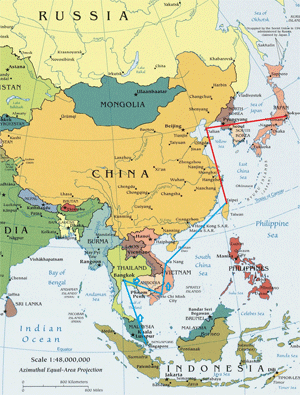
The last aeroplane journeys of Subhas Chandra Bose.
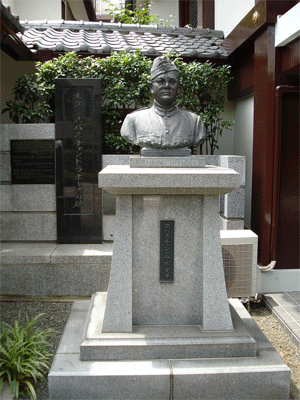
A memorial to Subhas Chandra Bose in the Renkōji Temple, Tokyo. Bose's ashes are stored in the temple in a golden pagoda.
In the consensus of scholarly opinion, Subhas Chandra Bose's death occurred from third-degree burns on 18 August 1945 after his overloaded Japanese plane crashed in Japanese-ruled Formosa (now Taiwan).[1][4] However, many among his supporters, especially in Bengal, refused at the time, and have refused since, to believe either the fact or the circumstances of his death.[1][25][26] Conspiracy theories appeared within hours of his death and have thereafter had a long shelf life,[1][z] keeping alive various martial myths about Bose.[2]
In Taihoku, at around 2:30 pm as the bomber with Bose on board was leaving the standard path taken by aircraft during take-off, the passengers inside heard a loud sound, similar to an engine backfiring.[72][73] The mechanics on the tarmac saw something fall out of the plane.[74] It was the portside engine, or a part of it, and the propeller.[74][72] The plane swung wildly to the right and plummeted, crashing, breaking into two, and exploding into flames.[74][72] Inside, the chief pilot, copilot and Lieutenant-General Tsunamasa Shidei, the Vice Chief of Staff of the Japanese Kwantung Army, who was to have made the negotiations for Bose with the Soviet army in Manchuria,[75] were instantly killed.[74][76] Bose's assistant Habibur Rahman was stunned, passing out briefly, and Bose, although conscious and not fatally hurt, was soaked in gasoline.[74] When Rahman came to, he and Bose attempted to leave by the rear door, but found it blocked by the luggage.[76] They then decided to run through the flames and exit from the front.[76] The ground staff, now approaching the plane, saw two people staggering towards them, one of whom had become a human torch.[74] The human torch turned out to be Bose, whose gasoline-soaked clothes had instantly ignited.[76] Rahman and a few others managed to smother the flames, but also noticed that Bose's face and head appeared badly burned.[76] According to Joyce Chapman Lebra, "A truck which served as ambulance rushed Bose and the other passengers to the Nanmon Military Hospital south of Taihoku."[74] The airport personnel called Dr. Taneyoshi Yoshimi, the surgeon-in-charge at the hospital at around 3 pm.[76] Bose was conscious and mostly coherent when they reached the hospital, and for some time thereafter.[77] Bose was naked, except for a blanket wrapped around him, and Dr. Yoshimi immediately saw evidence of third-degree burns on many parts of the body, especially on his chest, doubting very much that he would live.[77] Dr. Yoshimi promptly began to treat Bose and was assisted by Dr. Tsuruta.[77] According to historian Leonard A. Gordon, who interviewed all the hospital personnel later,
A disinfectant, Rivamol, was put over most of his body and then a white ointment was applied and he was bandaged over most of his body. Dr. Yoshimi gave Bose four injections of Vita Camphor and two of Digitamine for his weakened heart. These were given about every 30 minutes. Since his body had lost fluids quickly upon being burnt, he was also given Ringer solution intravenously. A third doctor, Dr. Ishii gave him a blood transfusion. An orderly, Kazuo Mitsui, an army private, was in the room and several nurses were also assisting. Bose still had a clear head which Dr. Yoshimi found remarkable for someone with such severe injuries.[78]
Soon, in spite of the treatment, Bose went into a coma.[78][74] A few hours later, between 9 and 10 PM (local time) on Saturday 18 August 1945, Bose died aged 48.[78][74]
Bose's body was cremated in the main Taihoku crematorium two days later, 20 August 1945.[79] On 23 August 1945, the Japanese news agency Do Trzei announced the death of Bose and Shidea.[74] On 7 September a Japanese officer, Lieutenant Tatsuo Hayashida, carried Bose's ashes to Tokyo, and the following morning they were handed to the president of the Tokyo Indian Independence League, Rama Murti.[80] On 14 September a memorial service was held for Bose in Tokyo and a few days later the ashes were turned over to the priest of the Renkōji Temple of Nichiren Buddhism in Tokyo.[81][82] There they have remained ever since.[82]
Among the INA personnel, there was widespread disbelief, shock, and trauma. Most affected were the young Tamil Indians from Malaya and Singapore, both men and women, who comprised the bulk of the civilians who had enlisted in the INA.[29] The professional soldiers in the INA, most of whom were Punjabis, faced an uncertain future, with many fatalistically expecting reprisals from the British.[29] In India the Indian National Congress's official line was succinctly expressed in a letter Mohandas Karamchand Gandhi wrote to Rajkumari Amrit Kaur.[29] Said Gandhi, "Subhas Bose has died well. He was undoubtedly a patriot, though misguided."[29] Many congressmen had not forgiven Bose for quarrelling with Gandhi and for collaborating with what they considered was Japanese fascism. The Indian soldiers in the British Indian army, some two and a half million of whom had fought during the Second World War, were conflicted about the INA. Some saw the INA as traitors and wanted them punished; others felt more sympathetic. The British Raj, though never seriously threatened by the INA, tried 300 INA officers for treason in the INA trials, but eventually backtracked.[29]
Legacy
Bose was featured on the stamps in India from 1964, 1993, 1997, 2001, 2016 and 2018.[83] Netaji Subhas Chandra Bose International Airport at Kolkata, Netaji Subhash Chandra Bose Island, formerly Ross Island and many other institutions in India are named after him. On 23 August 2007, Japanese Prime Minister, Shinzō Abe visited the Subhas Chandra Bose memorial hall in Kolkata.[84][85] Abe said to Bose's family "The Japanese are deeply moved by Bose's strong will to have led the Indian independence movement from British rule. Netaji is a much respected name in Japan.[84][85]
The following words are inscribed on a brass shield in front of the chair.
"Netaji Subhash Chandra Bose in order to free India from the shackles of British imperialism organized the Azad Hind Government from outside the country on October 21, 1943. Netaji set up the Provisional Government of Independent India (Azad Hind) and transferred its headquarter at Rangoon on January 7, 1944. On the 5th April, 1944, the "Azad Hind Bank" was inaugurated at Rangoon. It was on this occasion that Netaji used this chair for the first time. Later the chair was kept at the residence of Netaji at 51, University Avenue, Rangoon, where the office of the Azad Hind Government was also housed. Afterwards, at the time of leaving Burma, the Britishers handed over the chair to the family of Mr. A.T. Ahuja, the well known business man of Rangoon. The chair was officially handed over to the Government of India in January 1979. It was brought to Calcutta on the 17th July, 1980. It has now been ceremonially installed at the Red Fort on July 7, 1981."
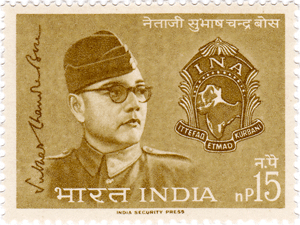
Bose on a 1964 stamp of India
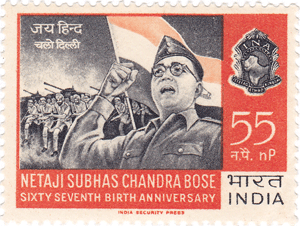
Bose on a 1964 stamp of India

